MERCEDES-BENZ SPRINTER 2011 MY11 Operator’s Manual
Manufacturer: MERCEDES-BENZ, Model Year: 2011, Model line: SPRINTER, Model: MERCEDES-BENZ SPRINTER 2011Pages: 292, PDF Size: 6.75 MB
Page 261 of 292
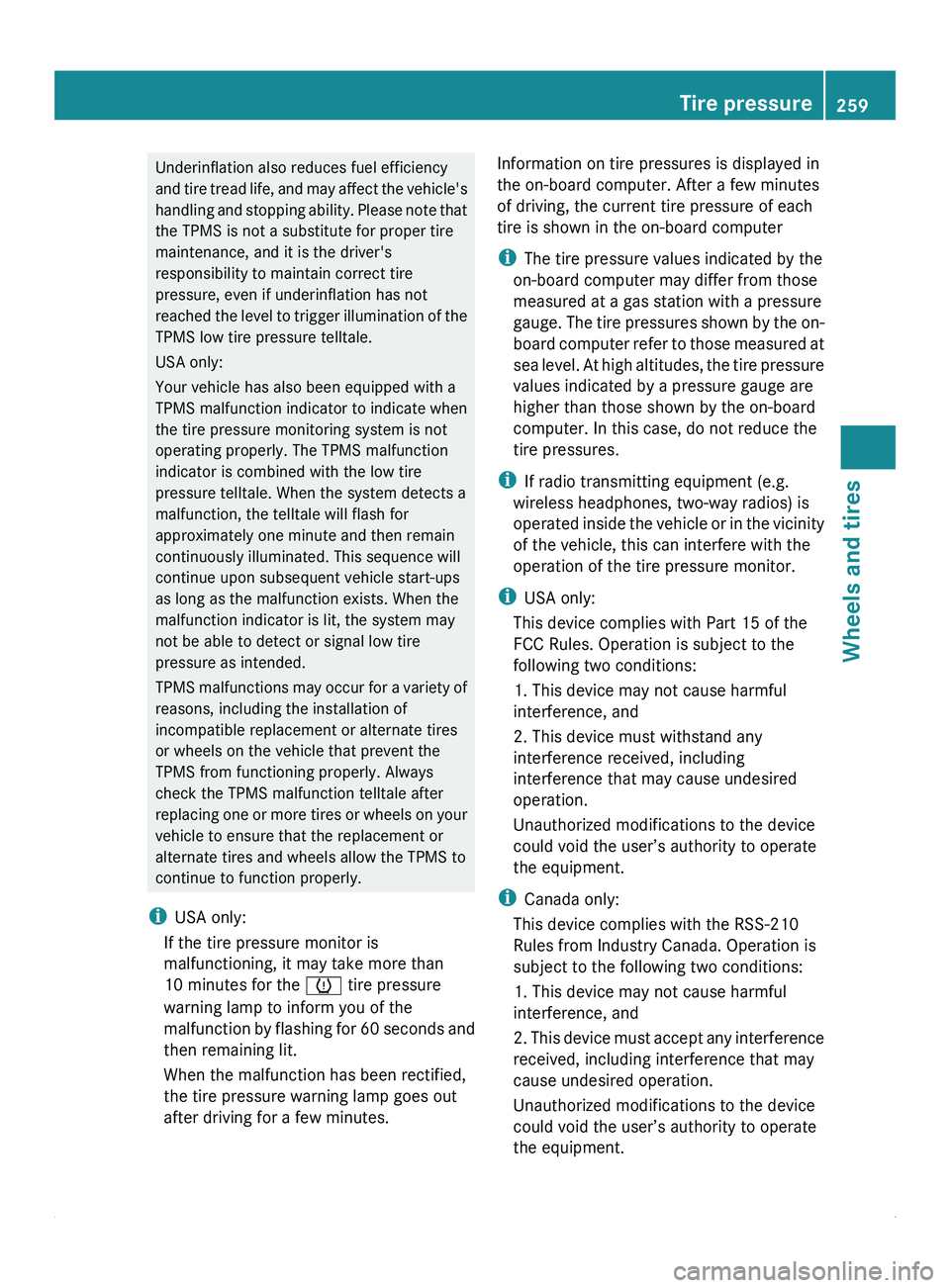
Underinflation also reduces fuel efficiency
and tire
tread
life, and may affect the vehicle's
handling and stopping ability. Please note that
the TPMS is not a substitute for proper tire
maintenance, and it is the driver's
responsibility to maintain correct tire
pressure, even if underinflation has not
reached the level to trigger illumination of the
TPMS low tire pressure telltale.
USA only:
Your vehicle has also been equipped with a
TPMS malfunction indicator to indicate when
the tire pressure monitoring system is not
operating properly. The TPMS malfunction
indicator is combined with the low tire
pressure telltale. When the system detects a
malfunction, the telltale will flash for
approximately one minute and then remain
continuously illuminated. This sequence will
continue upon subsequent vehicle start-ups
as long as the malfunction exists. When the
malfunction indicator is lit, the system may
not be able to detect or signal low tire
pressure as intended.
TPMS malfunctions may occur for a variety of
reasons, including the installation of
incompatible replacement or alternate tires
or wheels on the vehicle that prevent the
TPMS from functioning properly. Always
check the TPMS malfunction telltale after
replacing one or more tires or wheels on your
vehicle to ensure that the replacement or
alternate tires and wheels allow the TPMS to
continue to function properly.
i USA only:
If the tire pressure monitor is
malfunctioning, it may take more than
10 minutes for the 0077 tire pressure
warning lamp to inform you of the
malfunction by flashing for 60 seconds and
then remaining lit.
When the malfunction has been rectified,
the tire pressure warning lamp goes out
after driving for a few minutes. Information on tire pressures is displayed in
the on-board computer. After a few minutes
of driving, the current tire pressure of each
tire is shown in the on-board computer
i
The tire pressure values indicated by the
on-board computer may differ from those
measured at a gas station with a pressure
gauge. The tire
pressures shown by the on-
board computer refer to those measured at
sea level. At high altitudes, the tire pressure
values indicated by a pressure gauge are
higher than those shown by the on-board
computer. In this case, do not reduce the
tire pressures.
i If radio transmitting equipment (e.g.
wireless headphones, two-way radios) is
operated inside the vehicle or in the vicinity
of the vehicle, this can interfere with the
operation of the tire pressure monitor.
i USA only:
This device complies with Part 15 of the
FCC Rules. Operation is subject to the
following two conditions:
1. This device may not cause harmful
interference, and
2. This device must withstand any
interference received, including
interference that may cause undesired
operation.
Unauthorized modifications to the device
could void the user’s authority to operate
the equipment.
i Canada only:
This device complies with the RSS-210
Rules from Industry Canada. Operation is
subject to the following two conditions:
1. This device may not cause harmful
interference, and
2. This device must accept any interference
received, including interference that may
cause undesired operation.
Unauthorized modifications to the device
could void the user’s authority to operate
the equipment. Tire pressure
259
Wheels and tires Z
Page 262 of 292
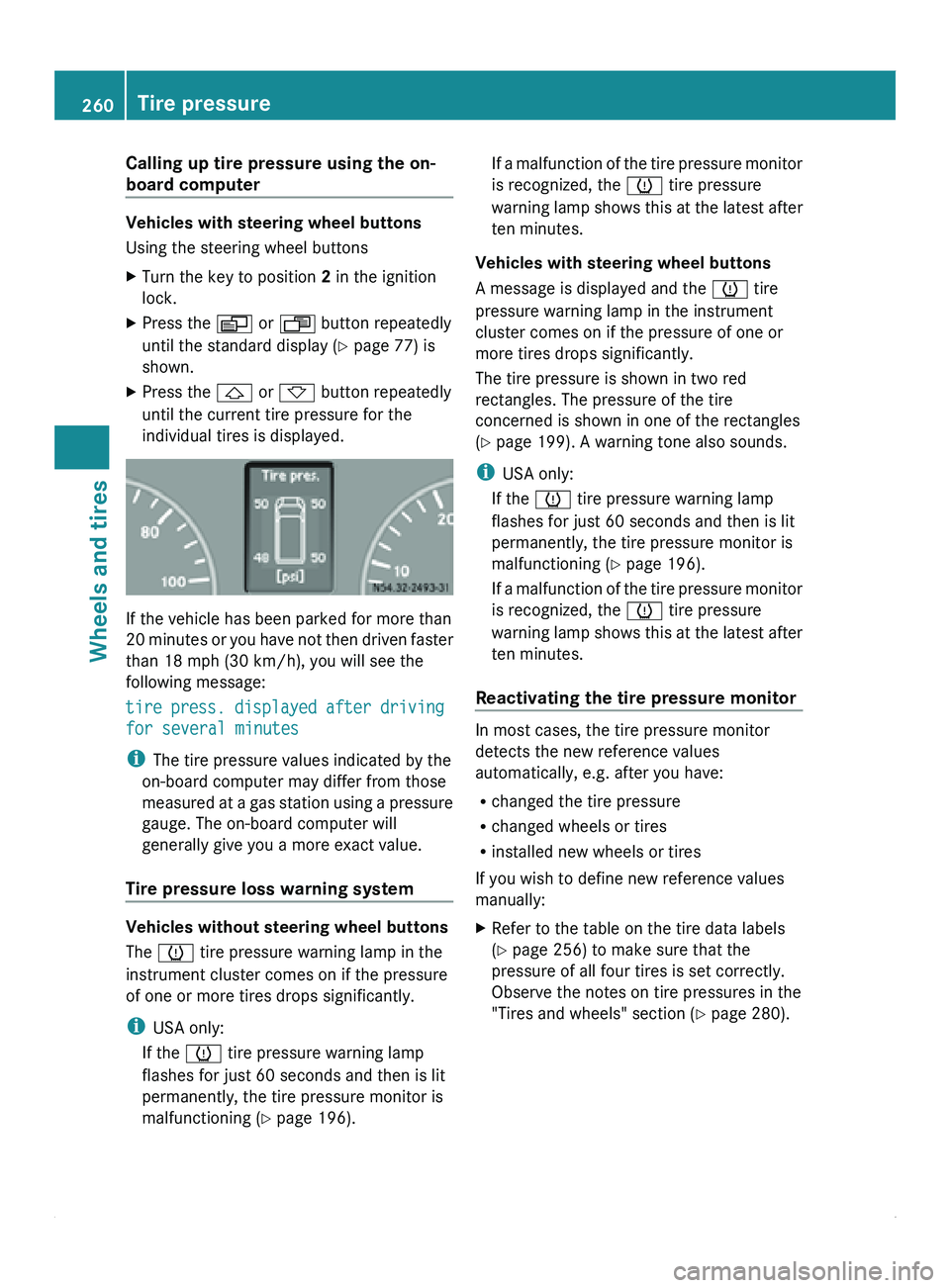
Calling up tire pressure using the on-
board computer
Vehicles with steering wheel buttons
Using the steering wheel buttons
X
Turn the key to position 2 in the ignition
lock.
X Press the 0059 or 0058 button repeatedly
until the standard display ( Y page 77) is
shown.
X Press the
0029 or 002D button repeatedly
until the current tire pressure for the
individual tires is displayed. If the vehicle has been parked for more than
20 minutes
or
you have not then driven faster
than 18 mph (30 km/h), you will see the
following message:
tire press. displayed after driving
for several minutes
i The tire pressure values indicated by the
on-board computer may differ from those
measured at a gas station using a pressure
gauge. The on-board computer will
generally give you a more exact value.
Tire pressure loss warning system Vehicles without steering wheel buttons
The 0077 tire pressure warning lamp in the
instrument cluster comes on if the pressure
of one or more tires drops significantly.
i
USA only:
If the 0077 tire pressure warning lamp
flashes for just 60 seconds and then is lit
permanently, the tire pressure monitor is
malfunctioning (Y page 196). If a malfunction of the tire pressure monitor
is recognized, the 0077 tire pressure
warning lamp
shows
this at the latest after
ten minutes.
Vehicles with steering wheel buttons
A message is displayed and the 0077 tire
pressure warning lamp in the instrument
cluster comes on if the pressure of one or
more tires drops significantly.
The tire pressure is shown in two red
rectangles. The pressure of the tire
concerned is shown in one of the rectangles
(Y page 199). A warning tone also sounds.
i USA only:
If the 0077 tire pressure warning lamp
flashes for just 60 seconds and then is lit
permanently, the tire pressure monitor is
malfunctioning (Y page 196).
If a malfunction of the tire pressure monitor
is recognized, the 0077 tire pressure
warning lamp shows this at the latest after
ten minutes.
Reactivating the tire pressure monitor In most cases, the tire pressure monitor
detects the new reference values
automatically, e.g. after you have:
R
changed the tire pressure
R changed wheels or tires
R installed new wheels or tires
If you wish to define new reference values
manually:
X Refer to the table on the tire data labels
(Y page 256) to make sure that the
pressure of all four tires is set correctly.
Observe the notes on tire pressures in the
"Tires and wheels" section ( Y page 280).260
Tire pressure
Wheels and tires
Page 263 of 292
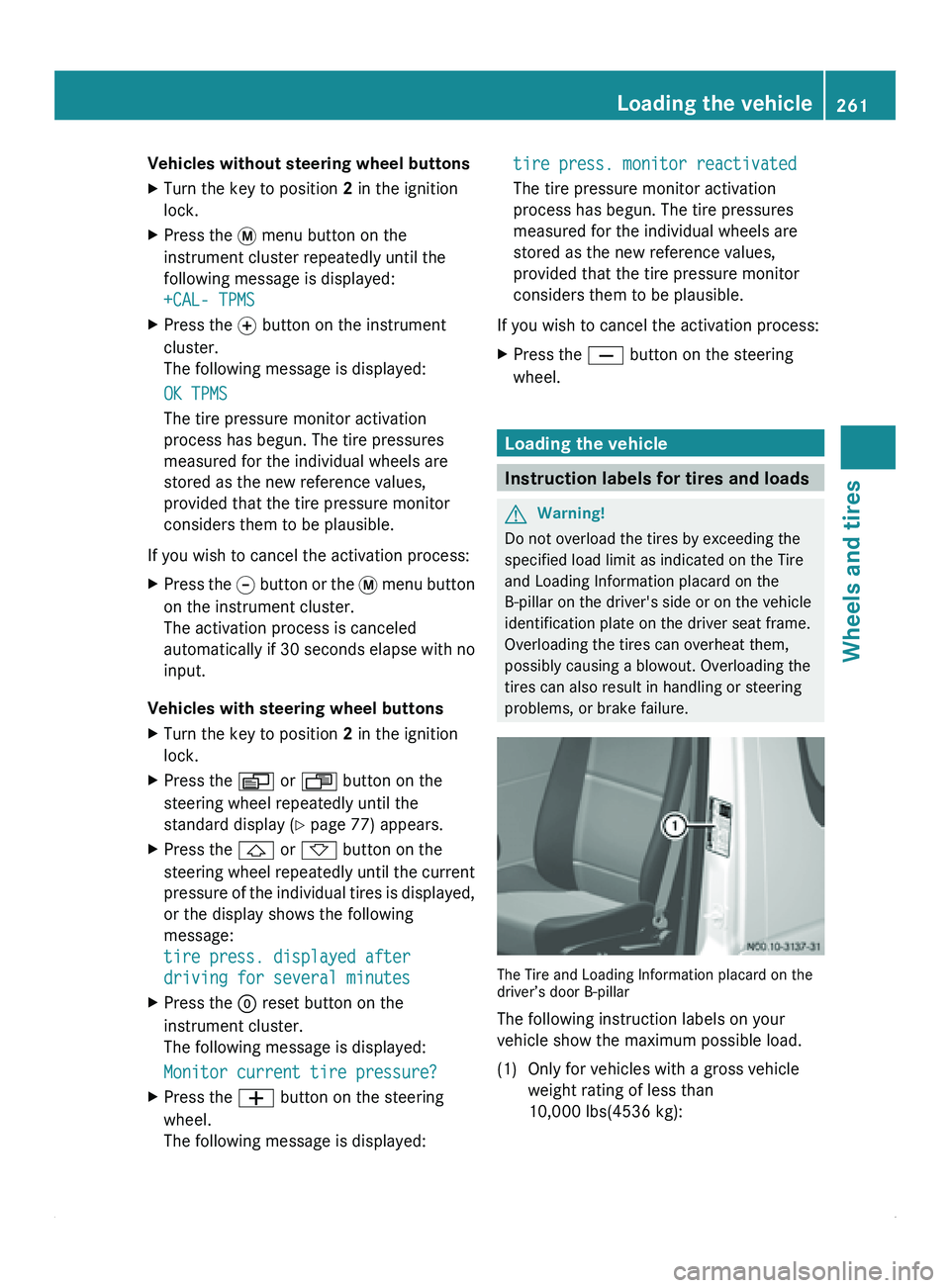
Vehicles without steering wheel buttons
X
Turn the key to position 2 in the ignition
lock.
X Press the 007B menu button on the
instrument cluster repeatedly until the
following message is displayed:
+CAL- TPMS
X Press the 0069 button on the instrument
cluster.
The following message is displayed:
OK TPMS
The tire pressure monitor activation
process has begun. The tire pressures
measured for the individual wheels are
stored as the new reference values,
provided that the tire pressure monitor
considers them to be plausible.
If you wish to cancel the activation process:
X Press the 006A button or the 007B menu button
on the instrument cluster.
The activation process is canceled
automatically if 30 seconds elapse with no
input.
Vehicles with steering wheel buttons
X Turn the key to position 2 in the ignition
lock.
X Press the 0059 or 0058 button on the
steering wheel repeatedly until the
standard display (Y
page 77) appears.
X Press the 0029 or 002D button on the
steering wheel repeatedly
until the current
pressure of the individual tires is displayed,
or the display shows the following
message:
tire press. displayed after
driving for several minutes
X Press the 0048 reset button on the
instrument cluster.
The following message is displayed:
Monitor current tire pressure?
X Press the 005A button on the steering
wheel.
The following message is displayed: tire press. monitor reactivated
The tire pressure monitor activation
process has begun. The tire pressures
measured for the individual wheels are
stored as the new reference values,
provided that the tire pressure monitor
considers them to be plausible.
If you wish to cancel the activation process:
X Press the 005B button on the steering
wheel. Loading the vehicle
Instruction labels for tires and loads
G
Warning!
Do not overload the tires by exceeding the
specified load limit as indicated on the Tire
and Loading Information placard on the
B-pillar on the driver's side or on the vehicle
identification plate on the driver seat frame.
Overloading the tires can overheat them,
possibly causing a blowout. Overloading the
tires can also result in handling or steering
problems, or brake failure. The Tire and Loading Information placard on the
driver’s door B-pillar
The following instruction labels on your
vehicle show the maximum possible load.
(1) Only for vehicles with a gross vehicle
weight rating of less than
10,000 lbs(4536 kg): Loading the vehicle
261
Wheels and tires Z
Page 264 of 292
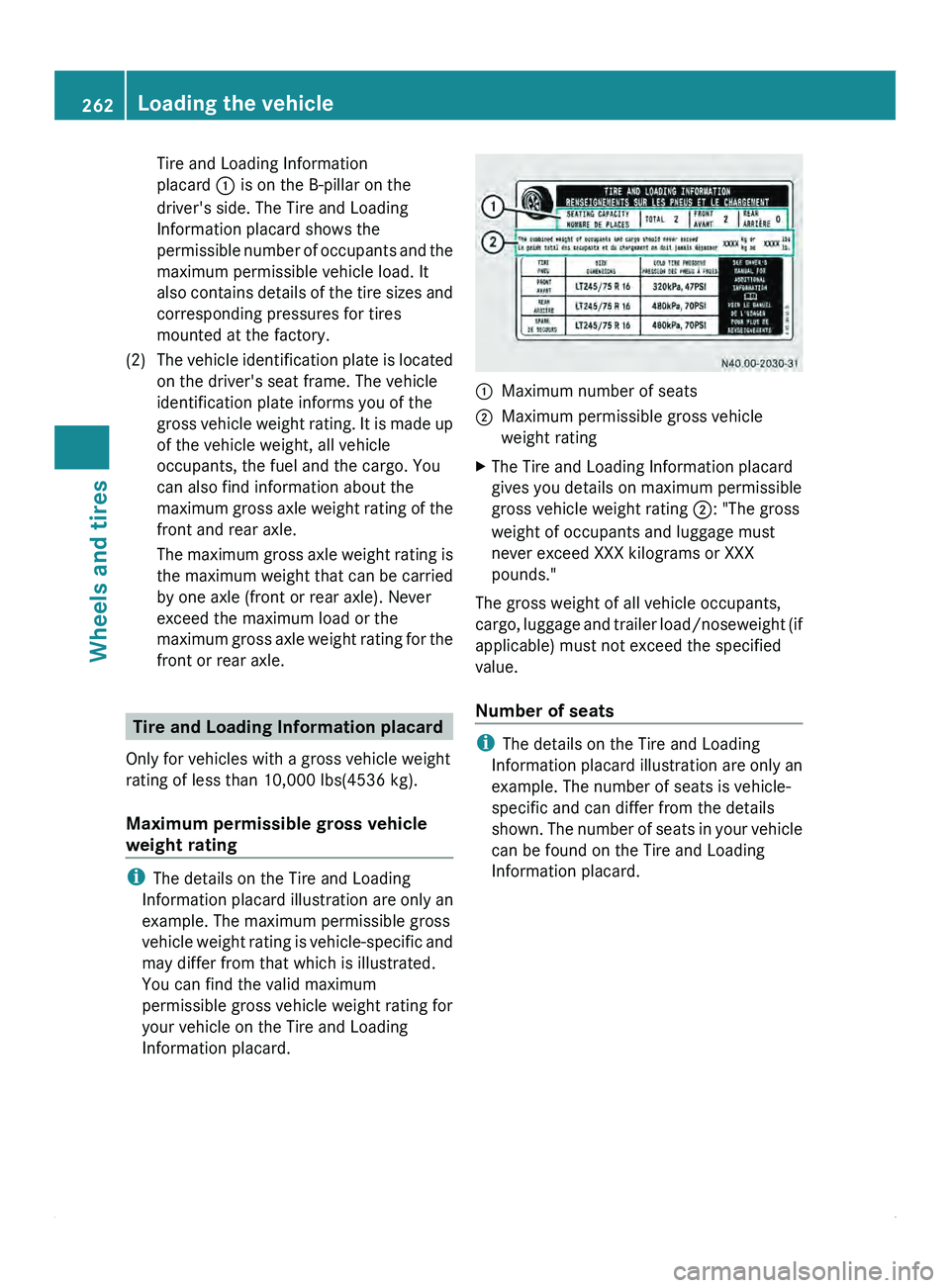
Tire and Loading Information
placard
0046 is on the B-pillar on the
driver's side. The Tire and Loading
Information placard shows the
permissible number of
occupants and the
maximum permissible vehicle load. It
also contains details of the tire sizes and
corresponding pressures for tires
mounted at the factory.
(2) The vehicle identification plate is located on the driver's seat frame. The vehicle
identification plate informs you of the
gross vehicle weight
rating. It is made up
of the vehicle weight, all vehicle
occupants, the fuel and the cargo. You
can also find information about the
maximum gross axle weight rating of the
front and rear axle.
The maximum gross axle weight rating is
the maximum weight that can be carried
by one axle (front or rear axle). Never
exceed the maximum load or the
maximum gross axle weight rating for the
front or rear axle. Tire and Loading Information placard
Only for vehicles with a gross vehicle weight
rating of less than 10,000 lbs(4536 kg).
Maximum permissible gross vehicle
weight rating i
The details on the Tire and Loading
Information placard illustration
are only an
example. The maximum permissible gross
vehicle weight rating is vehicle-specific and
may differ from that which is illustrated.
You can find the valid maximum
permissible gross vehicle weight rating for
your vehicle on the Tire and Loading
Information placard. 0046
Maximum number of seats
0047 Maximum permissible gross vehicle
weight rating
X The Tire and Loading Information placard
gives you details on maximum permissible
gross vehicle weight rating 0047: "The gross
weight of occupants and luggage must
never exceed XXX kilograms or XXX
pounds."
The gross weight of all vehicle occupants,
cargo, luggage
and
trailer load/noseweight (if
applicable) must not exceed the specified
value.
Number of seats i
The details on the Tire and Loading
Information placard illustration
are only an
example. The number of seats is vehicle-
specific and can differ from the details
shown. The number of seats in your vehicle
can be found on the Tire and Loading
Information placard. 262
Loading the vehicle
Wheels and tires
Page 265 of 292
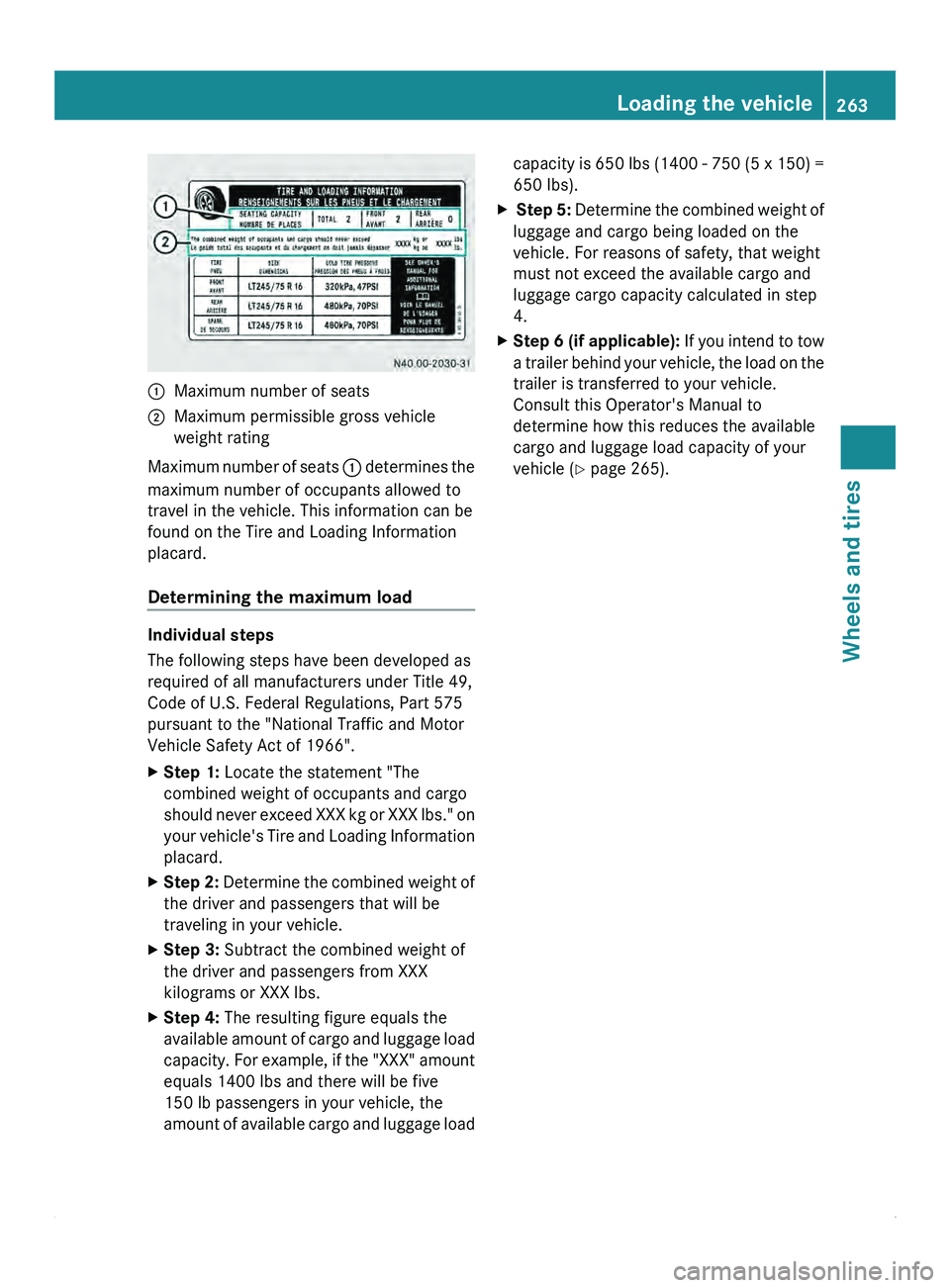
0046
Maximum number of seats
0047 Maximum permissible gross vehicle
weight rating
Maximum number of seats 0046 determines the
maximum number of occupants allowed to
travel in the vehicle. This information can be
found on the Tire and Loading Information
placard.
Determining the maximum load Individual steps
The following steps have been developed as
required of all manufacturers under Title 49,
Code of U.S. Federal Regulations, Part 575
pursuant to the "National Traffic and Motor
Vehicle Safety Act of 1966".
X
Step 1: Locate the statement "The
combined weight of occupants and cargo
should never exceed
XXX kg or XXX lbs." on
your vehicle's Tire and Loading Information
placard.
X Step 2: Determine the combined weight of
the driver and passengers that will be
traveling in your vehicle.
X Step 3: Subtract the combined weight of
the driver and passengers from XXX
kilograms or XXX lbs.
X Step 4: The resulting figure equals the
available amount of
cargo and luggage load
capacity. For example, if the "XXX" amount
equals 1400 lbs and there will be five
150 lb passengers in your vehicle, the
amount of available cargo and luggage load capacity is 650 lbs (1400 - 750 (5 x 150) =
650 lbs).
X Step 5: Determine the combined weight of
luggage and cargo being loaded on the
vehicle. For reasons of safety, that weight
must not exceed the available cargo and
luggage cargo capacity calculated in step
4.
X Step 6
(if applicable): If you
intend to tow
a trailer behind your vehicle, the load on the
trailer is transferred to your vehicle.
Consult this Operator's Manual to
determine how this reduces the available
cargo and luggage load capacity of your
vehicle ( Y page 265). Loading the vehicle
263
Wheels and tires Z
Page 266 of 292
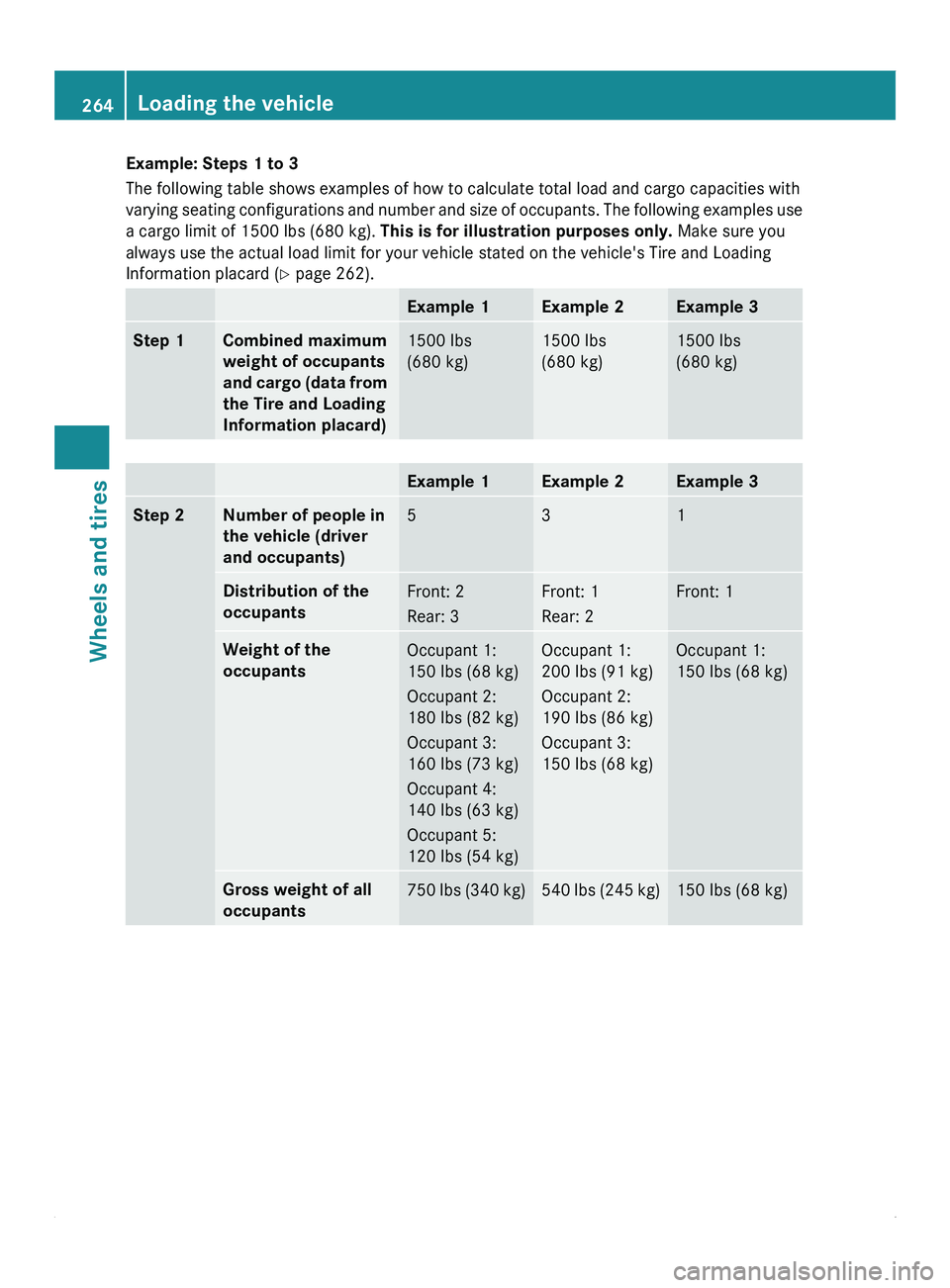
Example: Steps 1 to 3
The following table shows examples of how to calculate total load and cargo capacities with
varying seating
configurations
and number and size of occupants. The following examples use
a cargo limit of 1500 lbs (680 kg). This is for illustration purposes only. Make sure you
always use the actual load limit for your vehicle stated on the vehicle's Tire and Loading
Information placard (Y page 262). Example 1 Example 2 Example 3
Step 1 Combined maximum
weight of occupants
and cargo
(data
from
the Tire and Loading
Information placard) 1500 lbs
(680 kg) 1500 lbs
(680 kg) 1500 lbs
(680 kg)
Example 1 Example 2 Example 3
Step 2 Number of people in
the vehicle (driver
and occupants)
5 3 1
Distribution of the
occupants
Front: 2
Rear: 3 Front: 1
Rear: 2 Front: 1
Weight of the
occupants
Occupant 1:
150 lbs (68 kg)
Occupant 2:
180 lbs (82 kg)
Occupant 3:
160 lbs (73 kg)
Occupant 4:
140 lbs (63 kg)
Occupant 5:
120 lbs (54 kg) Occupant 1:
200 lbs (91 kg)
Occupant 2:
190 lbs (86 kg)
Occupant 3:
150 lbs (68 kg) Occupant 1:
150 lbs (68 kg)
Gross weight of all
occupants
750 lbs (340 kg) 540 lbs (245 kg) 150 lbs (68 kg)264
Loading the vehicle
Wheels and tires
Page 267 of 292
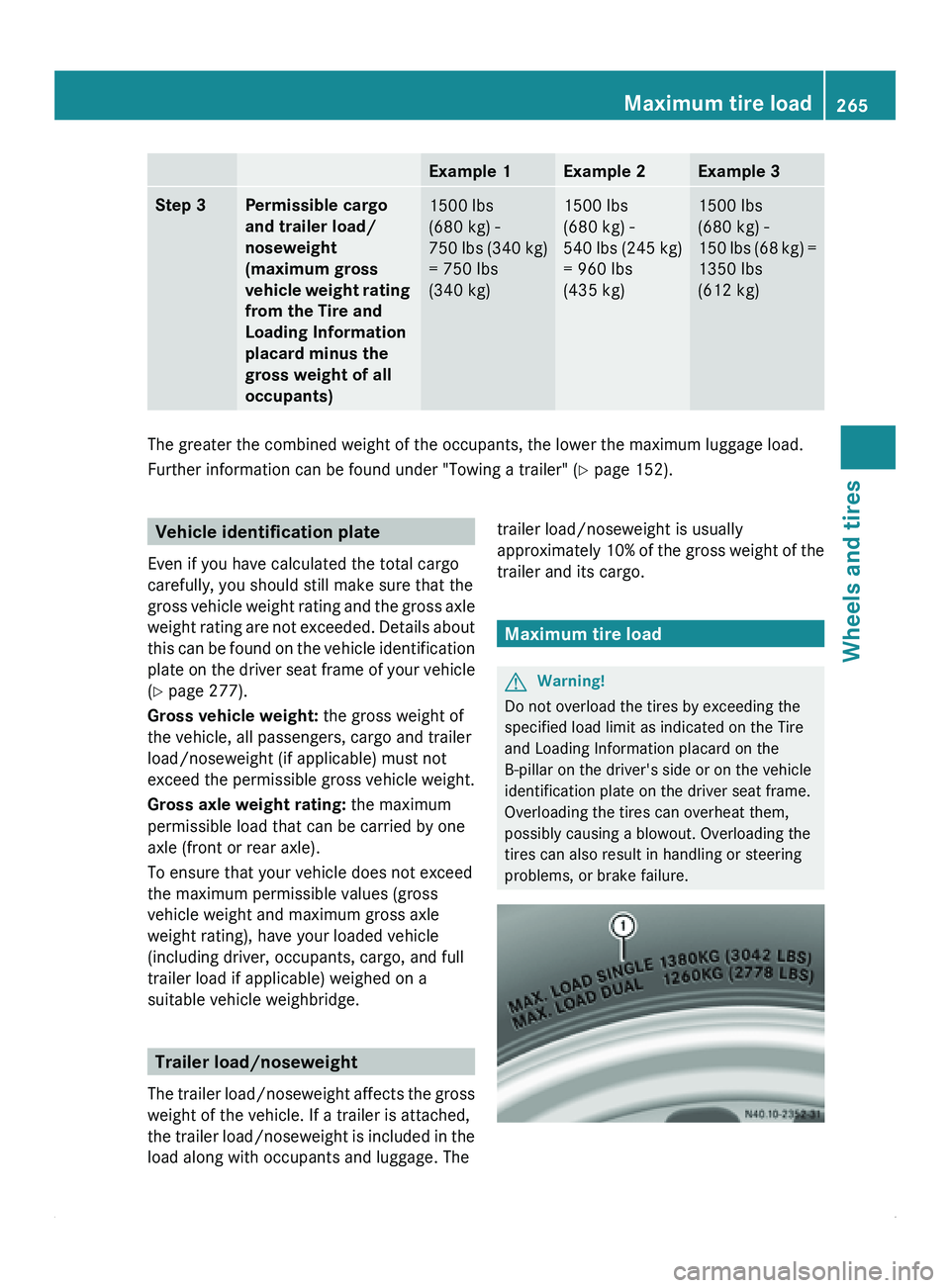
Example 1 Example 2 Example 3
Step 3 Permissible cargo
and trailer load/
noseweight
(maximum gross
vehicle weight
rating
from the Tire and
Loading Information
placard minus the
gross weight of all
occupants) 1500 lbs
(680 kg) -
750 lbs
(340
kg)
= 750 lbs
(340 kg) 1500 lbs
(680 kg) -
540 lbs
(245
kg)
= 960 lbs
(435 kg) 1500 lbs
(680 kg) -
150 lbs
(68
kg) =
1350 lbs
(612 kg) The greater the combined weight of the occupants, the lower the maximum luggage load.
Further information can be found under "Towing a trailer" (
Y page 152). Vehicle identification plate
Even if you have calculated the total cargo
carefully, you should still make sure that the
gross vehicle weight
rating and the gross axle
weight rating are not exceeded. Details about
this can be found on the vehicle identification
plate on the driver seat frame of your vehicle
(Y page 277).
Gross vehicle weight: the gross weight of
the vehicle, all passengers, cargo and trailer
load/noseweight (if applicable) must not
exceed the permissible gross vehicle weight.
Gross axle weight rating: the maximum
permissible load that can be carried by one
axle (front or rear axle).
To ensure that your vehicle does not exceed
the maximum permissible values (gross
vehicle weight and maximum gross axle
weight rating), have your loaded vehicle
(including driver, occupants, cargo, and full
trailer load if applicable) weighed on a
suitable vehicle weighbridge. Trailer load/noseweight
The trailer load/noseweight
affects the gross
weight of the vehicle. If a trailer is attached,
the trailer load/noseweight is included in the
load along with occupants and luggage. The trailer load/noseweight is usually
approximately 10%
of
the gross weight of the
trailer and its cargo. Maximum tire load
G
Warning!
Do not overload the tires by exceeding the
specified load limit as indicated on the Tire
and Loading Information placard on the
B-pillar on the driver's side or on the vehicle
identification plate on the driver seat frame.
Overloading the tires can overheat them,
possibly causing a blowout. Overloading the
tires can also result in handling or steering
problems, or brake failure. Maximum tire load
265
Wheels and tires Z
Page 268 of 292
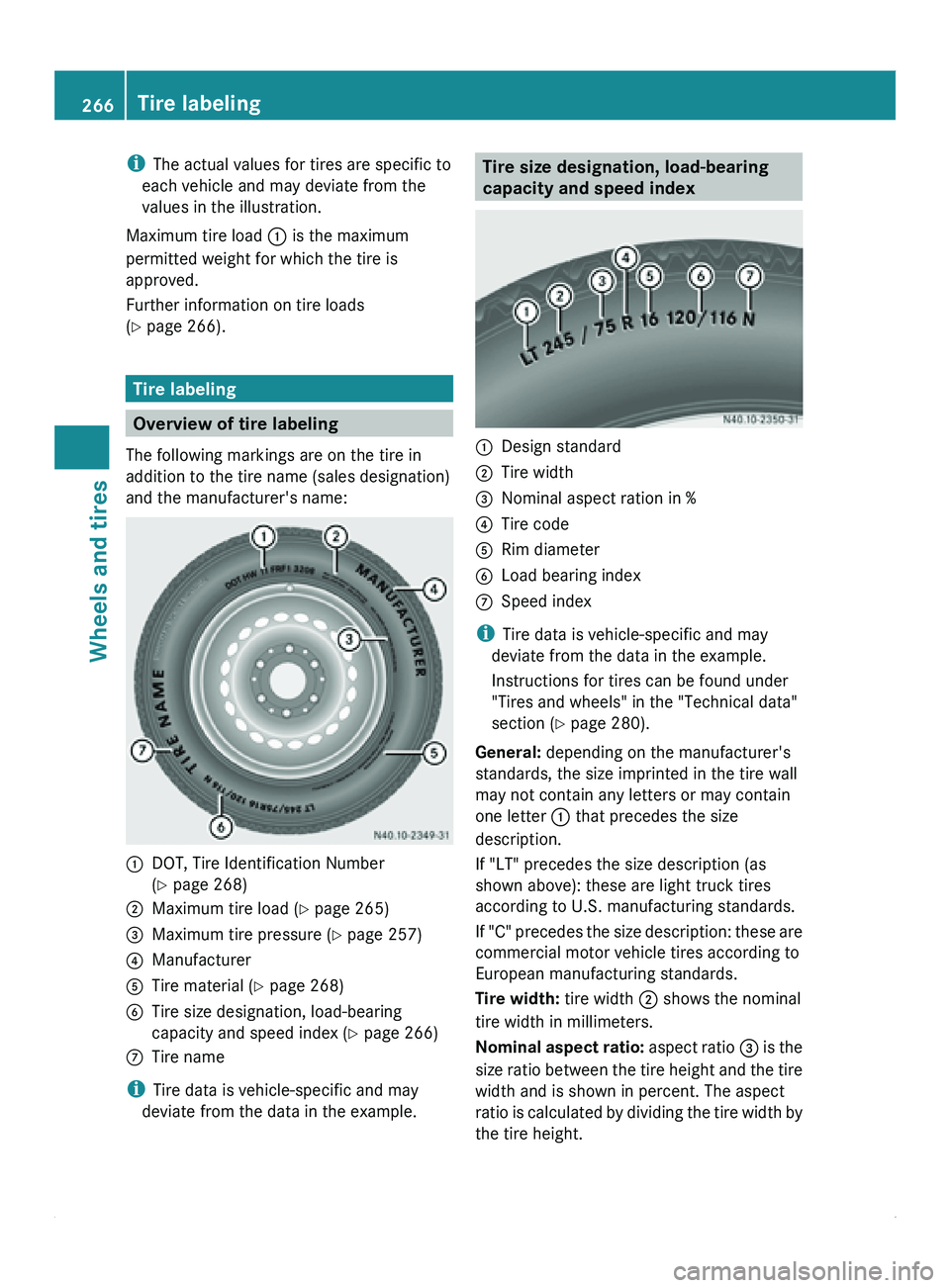
i
The actual values for tires are specific to
each vehicle and may deviate from the
values in the illustration.
Maximum tire load 0046 is the maximum
permitted weight for which the tire is
approved.
Further information on tire loads
(Y page 266). Tire labeling
Overview of tire labeling
The following markings are on the tire in
addition to the tire name (sales designation)
and the manufacturer's name: 0046
DOT, Tire Identification Number
(Y page 268)
0047 Maximum tire load ( Y page 265)
008A Maximum tire pressure (Y page 257)
0088 Manufacturer
0086 Tire material ( Y page 268)
0087 Tire size designation, load-bearing
capacity and speed index (
Y page 266)
006E Tire name
i Tire data is vehicle-specific and may
deviate from the data in the example. Tire size designation, load-bearing
capacity and speed index
0046
Design standard
0047 Tire width
008A Nominal aspect ration in %
0088 Tire code
0086 Rim diameter
0087 Load bearing index
006E Speed index
i Tire data is vehicle-specific and may
deviate from the data in the example.
Instructions for tires can be found under
"Tires and wheels" in the "Technical data"
section ( Y page 280).
General: depending on the manufacturer's
standards, the size imprinted in the tire wall
may not contain any letters or may contain
one letter 0046 that precedes the size
description.
If "LT" precedes the size description (as
shown above): these are light truck tires
according to U.S. manufacturing standards.
If "C"
precedes
the size description: these are
commercial motor vehicle tires according to
European manufacturing standards.
Tire width: tire width 0047 shows the nominal
tire width in millimeters.
Nominal aspect ratio: aspect ratio 008A is the
size ratio between the tire height and the tire
width and is shown in percent. The aspect
ratio is calculated by dividing the tire width by
the tire height. 266
Tire labeling
Wheels and tires
Page 269 of 292
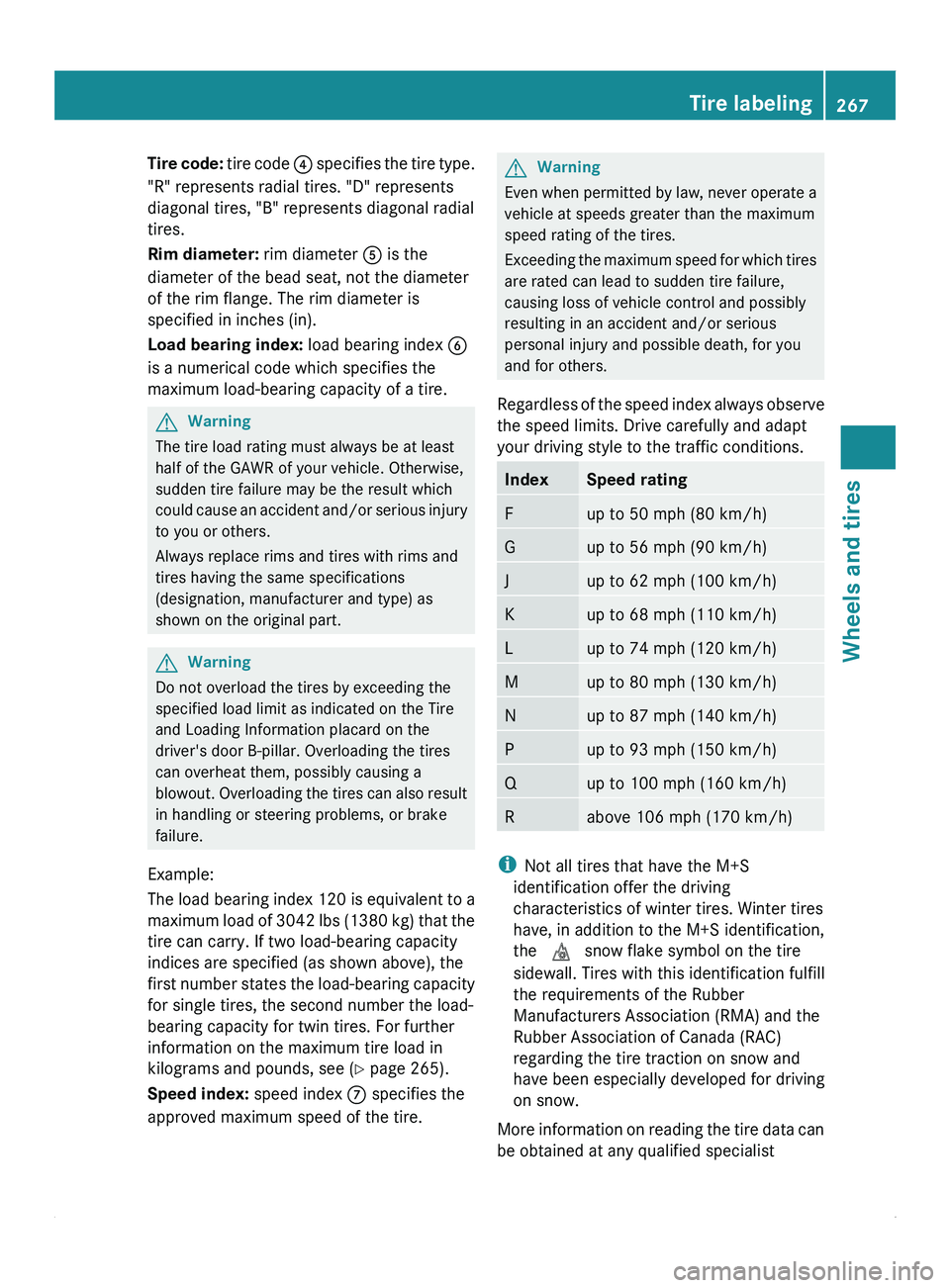
Tire code:
tire code 0088 specifies the tire type.
"R" represents radial tires. "D" represents
diagonal tires, "B" represents diagonal radial
tires.
Rim diameter: rim diameter 0086 is the
diameter of the bead seat, not the diameter
of the rim flange. The rim diameter is
specified in inches (in).
Load bearing index: load bearing index 0087
is a numerical code which specifies the
maximum load-bearing capacity of a tire. G
Warning
The tire load rating must always be at least
half of the GAWR of your vehicle. Otherwise,
sudden tire failure may be the result which
could cause an
accident and/or serious injury
to you or others.
Always replace rims and tires with rims and
tires having the same specifications
(designation, manufacturer and type) as
shown on the original part. G
Warning
Do not overload the tires by exceeding the
specified load limit as indicated on the Tire
and Loading Information placard on the
driver's door B-pillar . Overloading the tires
can overheat them, possibly causing a
blowout. Overloading
the tires can also result
in handling or steering problems, or brake
failure.
Example:
The load bearing index 120 is equivalent to a
maximum load of 3042 lbs (1380 kg) that the
tire can carry. If two load-bearing capacity
indices are specified (as shown above), the
first number states the load-bearing capacity
for single tires, the second number the load-
bearing capacity for twin tires. For further
information on the maximum tire load in
kilograms and pounds, see ( Y page 265).
Speed index: speed index 006E specifies the
approved maximum speed of the tire. G
Warning
Even when permitted by law, never operate a
vehicle at speeds greater than the maximum
speed rating of the tires.
Exceeding the maximum
speed for which tires
are rated can lead to sudden tire failure,
causing loss of vehicle control and possibly
resulting in an accident and/or serious
personal injury and possible death, for you
and for others.
Regardless of the speed index always observe
the speed limits. Drive carefully and adapt
your driving style to the traffic conditions. Index Speed rating
F up to 50 mph (80 km/h)
G up to 56 mph (90 km/h)
J up to 62 mph (100 km/h)
K up to 68 mph (110 km/h)
L up to 74 mph (120 km/h)
M up to 80 mph (130 km/h)
N up to 87 mph (140 km/h)
P up to 93 mph (150 km/h)
Q up to 100 mph (160 km/h)
R above 106 mph (170 km/h)
i
Not all tires that have the M+S
identification offer the driving
characteristics of winter tires. Winter tires
have, in addition
to the M+S identification,
the 004D snow flake symbol on the tire
sidewall. Tires with this identification fulfill
the requirements of the Rubber
Manufacturers Association (RMA) and the
Rubber Association of Canada (RAC)
regarding the tire traction on snow and
have been especially developed for driving
on snow.
More information on reading the tire data can
be obtained at any qualified specialist Tire labeling
267
Wheels and tires Z
Page 270 of 292
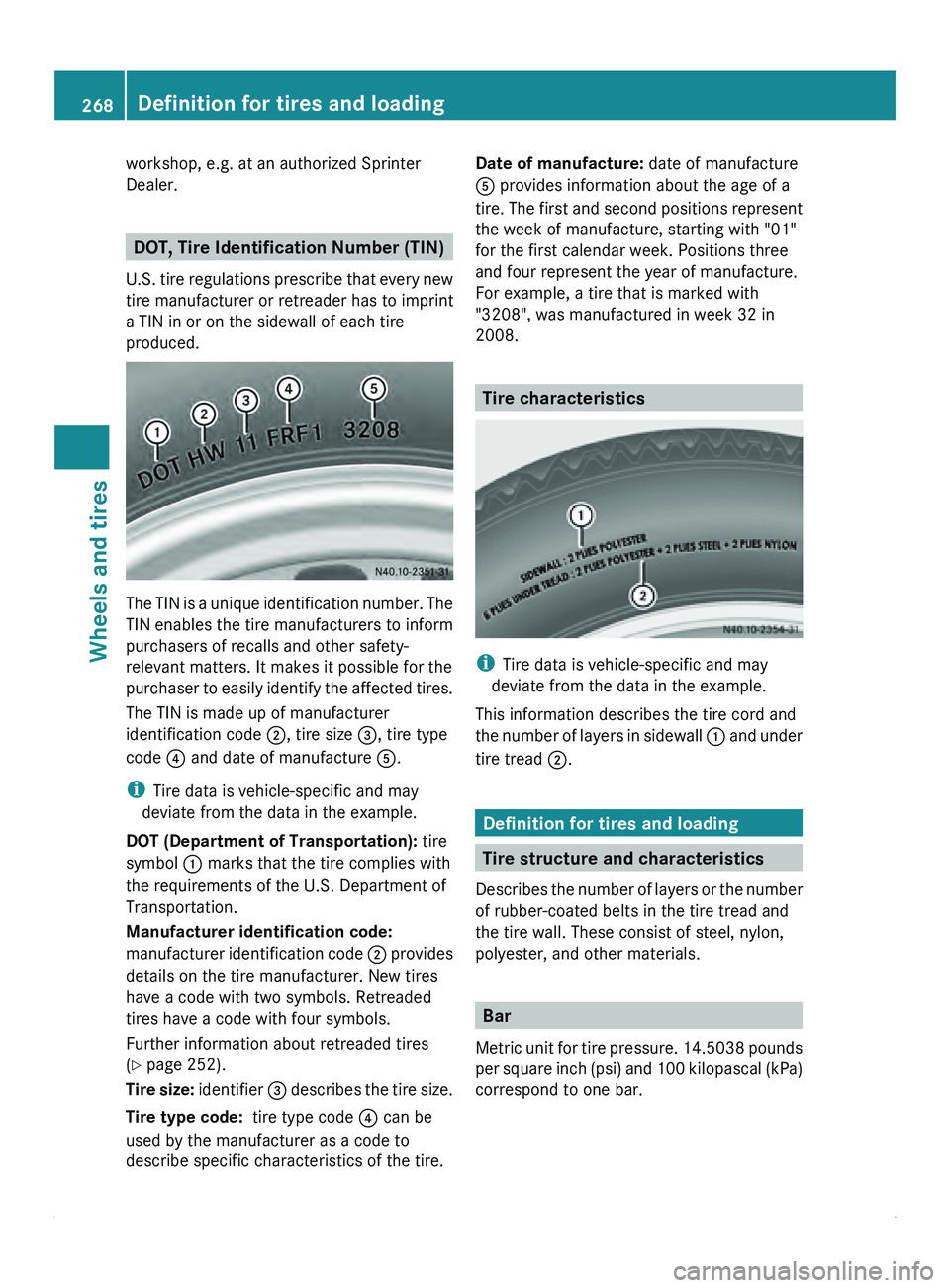
workshop, e.g. at an authorized Sprinter
Dealer.
DOT, Tire Identification Number (TIN)
U.S. tire regulations
prescribe that every new
tire manufacturer or retreader has to imprint
a TIN in or on the sidewall of each tire
produced. The TIN is a unique identification number. The
TIN enables the tire manufacturers to inform
purchasers of recalls and other safety-
relevant matters. It makes it possible for the
purchaser to
easily
identify the affected tires.
The TIN is made up of manufacturer
identification code 0047, tire size 008A, tire type
code 0088 and date of manufacture 0086.
i Tire data is vehicle-specific and may
deviate from the data in the example.
DOT (Department of Transportation): tire
symbol 0046 marks that the tire complies with
the requirements of the U.S. Department of
Transportation.
Manufacturer identification code:
manufacturer identification code 0047 provides
details on the tire manufacturer. New tires
have a code with two symbols. Retreaded
tires have a code with four symbols.
Further information about retreaded tires
(Y page 252).
Tire size: identifier 008A describes the tire size.
Tire type code: tire type code 0088 can be
used by the manufacturer as a code to
describe specific characteristics of the tire. Date of manufacture:
date of manufacture
0086 provides information about the age of a
tire. The
first
and second positions represent
the week of manufacture, starting with "01"
for the first calendar week. Positions three
and four represent the year of manufacture.
For example, a tire that is marked with
"3208", was manufactured in week 32 in
2008. Tire characteristics
i
Tire data is vehicle-specific and may
deviate from the data in the example.
This information describes the tire cord and
the number of
layers in sidewall 0046 and under
tire tread 0047. Definition for tires and loading
Tire structure and characteristics
Describes the number
of layers or the number
of rubber-coated belts in the tire tread and
the tire wall. These consist of steel, nylon,
polyester, and other materials. Bar
Metric unit for
tire pressure. 14.5038 pounds
per square inch (psi) and 100 kilopascal (kPa)
correspond to one bar. 268
Definition for tires and loading
Wheels and tires